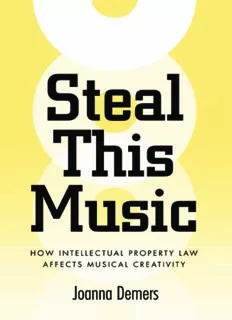
Demers-Steal This Music-How Intellectual Property Law Affects Musical Creativity PDF
Preview Demers-Steal This Music-How Intellectual Property Law Affects Musical Creativity
this page intentionally left blank StealThis Music Steal This Music HOW INTELLECTUAL PROPERTY LAW AFFECTS MUSICAL CREATIVITY JoannaDemers THE UNIVERSITY OF GEORGIA PRESS ATHENSANDLONDON ©2006bytheUniversityofGeorgiaPress Athens,Georgia30602 Allrightsreserved DesignedbyKathiDaileyMorgan&AnneRichmondBoston SetinElectrabyBookcomp PrintedandboundbyMaple-Vail Thepaperinthisbookmeetstheguidelinesforpermanence anddurabilityoftheCommitteeonProductionGuidelines forBookLongevityoftheCouncilonLibraryResources. PrintedintheUnitedStatesofAmerica 06 07 08 09 10 C 5 4 3 2 1 06 07 08 09 10 P 5 4 3 2 1 LibraryofCongressCataloging-in-PublicationData Demers,JoannaTeresa,1975– Stealthismusic:howintellectualproperty lawaffectsmusicalcreativity/JoannaDemers. p.cm. Includesbibliographicalreferencesandindex. ISBN-13:978-0-8203-2710-5(hardcover:alk.paper) ISBN-10:0-8203-2710-7(hardcover:alk.paper) ISBN-13:978-0-8203-2777-8(pbk.:alk.paper) ISBN-10:0-8203-2777-8(pbk.:alk.paper) 1.Copyright—Music—UnitedStates. 2.Composition (Music) 3.Intellectualproperty—UnitedStates. I.Title. KF3035.D462006 346.7304'82—dc22 2005021226 BritishLibraryCataloging-in-PublicationDataavailable CONTENTS MakingMusicintheSoundscapesoftheLaw, byRosemaryCoombe vii Acknowledgments xiii Introduction 1 ChapterOne MusicasIntellectualProperty 11 ChapterTwo ArrangementsandMusicalAllusion 31 ChapterThree Duplication 71 ChapterFour TheShadowoftheLaw 111 Notes 147 Bibliography 159 Index 171 MAKING MUSIC IN THE SOUNDSCAPES OF THE LAW Althoughcopyrightappliestomanyculturalexpressions,itsexten- sion into the field of musical creativity manifests most clearly the complexitiesofthelawandtherangeofitsculturalinfluence.From itsoriginsasarighttoprohibittheunauthorizedcopyingofsheet music,musicalcopyrighthasdramaticallyexpanded.Withrespect to musical compositions, the law now enables copyright holders toenjoinpublicperformances,broadcasting,themakingofsound recordingsinanymedium,and,inmanyjurisdictions,thesharing ofmusicwiththeaidofdigitaltechnology.Eachoftheseexclusive rightscanbeseparatelyassignedormultiplylicensedfordistinctpur- poses,potentiallycreatingtangledwebsofprohibitionthatfreight theuseofmusicwithdangersoflitigation.Moreandmoreperfor- mancesarenowconsideredpublic(forexample,songssungatfamily mealsinrestaurants,atchildren’sdaycarecenters,andatsummer camps), and the reproduction of even short samples of a song is potentiallyaninfringementiftheoriginalworkisrecognizable. Thereachofcopyrightlawhasextendedfarbeyondcompositions toencompasssoundrecordingsandperformancesasunique“works” ofcreativitydeservingprotection.Rightsoverrecordingsandperfor- mances,knownasneighboringrights,inmanyjurisdictionsaresim- ply incorporated into existing copyright statutes. They exacerbate vii viii ROSEMARY COOMBE the already complicated webs of protection woven around musi- calworks.Termsofcopyrightprotectionhavebecomeprogressively longer, ensuring that fewer and fewer works of musical creativity enterthepublicdomain.Therealmofactsexemptfrominfringe- mentliability—includingcertainreproductions,performances,and communicationsofmusicalworks—hasnotexpandedasrapidlyas thebodyoflimitationsthatincreasinglyencroachupontherangeof socialactivitiesinwhichmusicmaybeenjoyed.Eventhephysical mediaforfixingmusichavebeentaxed,andlegislatorshavepassed laws against circumventing technological “locks” used to prevent copyingofelectronicmediaevenwheresomeofthecopyingthenew laws prevent might actually be permitted under traditional copy- rightlaws.Althoughthereisarichbodyofcaselawelaboratingthe public’srighttofairdealingandfairuseofworks,copyrightowners seektocircumventit.Inanycase,howeverpotentiallygenerous,fair use is valuable only to those who can afford the fees necessary for aggressivelitigation.Mostfansandcreatorswhosharemusicwillbe sufficientlyintimidatedbyacorporate“cease-and-desistletter”on legalletterheadtostoptheiroffendingactivity—regardlessofhow creative,transformative,noncommercial,ornoncompetitiveitmay be—go underground, or pay a licensing fee set by corporate fiat. Meanwhile,therecordingindustrythattendstocontrolthegreat- est concentration of copyrights in musical works has also learned todeploycontractlaw,trademarklaw,commonlawunfaircompeti- tionsuits,andevenpublicityrightstolimitlisteningpracticesand creativeuseofmusicwithoutauthorizationandpayment. This legal situation leaves us with a musical culture structured primarily in favor of the financial interests of corporate intellec- tualpropertyholdersandshapedbythecontractualconditionsthey establish.Anypresumptionthatmusicservespublicpurposesand helps support social objectives seems to have vanished just as any notionthatthestateshouldacttoprotectthepublicinterestand
Description: